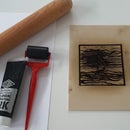Introduction: Pocket Size Spinthariscope
The spinthariscope was invented by William Crookes in 1903. While observing the apparently uniform fluorescence on a zinc sulfide screen created by the radioactive emissions (mostly alpha radiation) of a sample of radium bromide, he spilled some of the sample, and, owing to its extreme rarity and cost, he was eager to find and recover it.
Upon inspecting the zinc sulfide screen under a microscope, he noticed separate flashes of light created by individual alpha particle collisions with the screen. Crookes took his discovery a step further and invented a device specifically intended to view these scintillations.
It consisted of a small screen coated with zinc sulfide affixed to the end of a tube, with a tiny amount of radium salt suspended a short distance from the screen and a lens on the other end of the tube for viewing the screen. Crookes named his device from Greek σπινθήρ (spinth´ēr) "spark".
NOTE
What's the difference between the upgraded, and regular version? The previous version used a reflection based fixed scintillation screen, while this version uses a transmission based adjustable scintillation screen. Compared to the previous version this one offers an increased scintillation rate, and the ability to set the distance between the source and the screen.
Step 1: Safety First
To build this device you'll need to deal with a radioactive substance: Americium 241.
In the process of radioactive decay, americium releases alpha particles and gamma rays. Alpha particles are relatively high energy particles, but travel only extremely short distances and do not penetrate the skin.
However, if americium is taken into the body and enters body tissues, alpha particles may produce damage to nearby cells.
The radiation from americium is the primary cause of adverse health effects from absorbed americium. Upon entering the body by any route of exposure, americium moves relatively rapidly through the body and is deposited on the surfaces of the bones where it remains for a long time.
The dose from this alpha and gamma radiation can cause changes in the genetic material of these cells that could result in health effects such as bone cancers.
Gamma rays can travel much greater distances and can penetrate the entire body. Since alpha particles do not penetrate the skin and the gamma rays released from americium sources are relatively low in energy, external exposure to americium is not usually considered to be a danger to your health.
Anyway you must use at least eye protection, dust mask and rubber gloves when dealing with Americium 241.
Step 2: The Legal Bit
Disassembling a smoke detector
Disassembling a smoke detector to obtain the americium source may be subject to laws in your country, and that proceeding could open you to legal liability.
You must check the laws in your country before disassembling a smoke detector.
Disposal
State and local requirements for disposal of ionization smoke alarms vary. Some States conduct an annual roundup of ionization smoke detectors similar to that for hazardous household chemicals. Others allow ionization smoke detectors to be thrown out with ordinary trash but recommend that used smoke alarms be returned to the supplier. Some States require that used smoke detectors be returned to the supplier.
You must check with your local solid waste district, hazardous waste program, or health department to find out the procedures in your area.
Step 3: Materials Needed
To build this pocket size spinthariscope you will need:
- ionization smoke alarm (you can find them online but you will probably find cheaper ones at your local hardware store)
- this multipurpose 60x pocket microscope
- Zinc Sulphide glow-in-the-dark powder
- scotch tape
- M8x30 screw and M8 nut
- glue (I used cyanoacrylate)
- pliers...
...and a 3d printer. Or a friend with a 3d printer ;)
The only purpose of the ionization smoke alarm is to be disassembled to provide me the radioactive source. Now, I am not going to elaborate how ionization chamber works inside smoke alarms because it will digress from our current topic. What I was interested was extracting the radioactive source inside the smoke detector; and so I did.
Step 4: 3D Model
I designed a microscope extension to host both the radioactive source and the scintillation screen. You simply need to download the STL file and print your own extension.
Should you need to modify it just use the STEP file and import it in your design software.
Step 5: Assembly and Test
The assembly is pretty straightforward:
- wear your gloves, eye protection and dust mask and remove the Americium 241 source from the smoke detector. You will need just the small button shown in the pictures (this instructable could help).
- remove the light module from the microscope.
- grab the 3D part you just printed.
- glue the M8 nut in the hexagonal recess, it should be a tight fit so may need to push a little to get it in place.
- glue the americium source on the tip of the M8 screw.
- lay down some scotch tape with the sticky face facing upward, spread some ZnS powder on it and distribute it evenly.
- cut the scotch tape to obtain a disc with a diameter of 15 mm
- fit the disc into the 3D printed part with the sticky face (the face will not be so sticky now) in contact with the 3D printed part.
- glue the microscope into the 3D printed part.
- set the focus in order to get a clear view of the powder grains on the scotch tape
- Fit the M8 screw in the M8 nut and gently screw it all in
Put the spinthariscope in a dark place to let the powder go dark.
Step 6: Conclusions
Americium-241 emits mostly alpha particles (and a negligible portion of gamma emission) with average energy of 4.5 million electron volts (MeV). Each source contains less than 0.5 micrograms of americium dioxide with an activity of 0.8 microcuries which is equivalent to about 30000 nuclear disintegration per second.
When alpha particle travel in air at great speed, in this case about 15000 kilometres per second (based on 4.5 MeV relativistic kinetic energy) it has high probability to collide with anything that comes in their way due to its relative huge size. Usually these particles don't travel far, about 4 centimeters at most in air and will lose their energy in scattering events. It is like smashing a cue ball into a pool table full of billiard balls - eventually the cue ball will stop as it deposits its kinetic energy into the surrounding ball during collisions.
When collided in just the right way with the right materials, the passage of an alpha particle can be "seen". This is done with a process physicists call "scintillation".
A suitable material such as ZnS:Ag or ZnS:Cu (zinc sulfide doped with silver or copper) will emit flashes of light when it is being collided by alpha particles.
The light emitted is blue for ZnS:Ag and green for ZnS:Cu.
I did not see anything at first but it was no surprise, because each scintillation is very faint. But when our eyes adapt to the dark, they have higher capability to detect those faint flashes of light and it will usually take about 15 to 20 minutes to reach that kind of sensitivity in darkness.
Adjusting the position of the screw you can adjust the distance between the source and the screen. The number of scintillations will rapidly decrease if you increase the distance.
In vacuum the scintillation density obeys an inverse square law – getting weaker with the square of distance, i.e. doubling the distance quarters the intensity. Tripling the distance leads to a ninth of the intensity. In air you need also to consider the scattering, so the scintillation density will get even weaker.
So you did it! You juts gained a superpower! You can see the subatomic world with your bare eyes now!
Have fun! :)
Acknowledgement
I'd like to tanks all the users that commented this instructable for their contribute to make it better and safer!

Participated in the
Pocket Sized Contest















